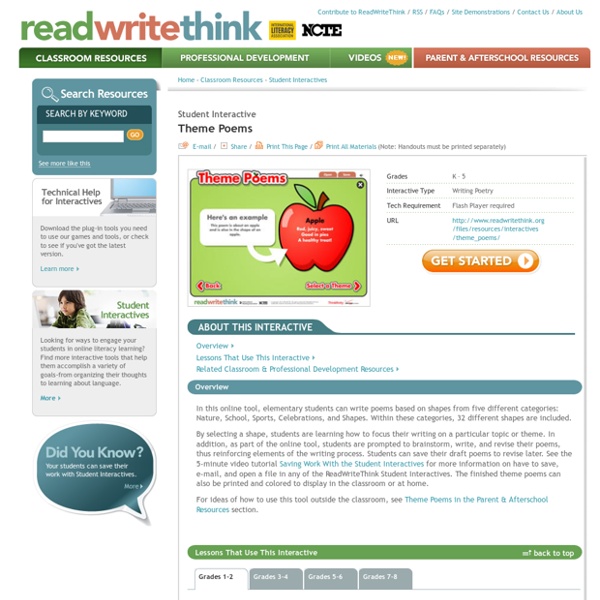Acrostic Poems
Grades 3 – 5 | Lesson Plan | Standard Lesson Vocabulary Solutions: A Mixture of Science, Conversation, and Writing In this lesson, students conduct a science experiment and later discuss the events of the lab during shared writing.
Create-a-Story
By Craig Gill Age Range: 7 to 11 This resource can be used to help children who may lack ideas during creative writing lessons. It consists of four charts, which contain 81 characters, 81 places, 81 situations and 81 objects. WARNING - some of them are a little gruesome!
Crossword Puzzles
Download the plug-in tools you need to use our games and tools, or check to see if you've got the latest version. Learn more Looking for ways to engage your students in online literacy learning? Find more interactive tools that help them accomplish a variety of goals-from organizing their thoughts to learning about language. More
Haiku Poem Interactive
Download the plug-in tools you need to use our games and tools, or check to see if you've got the latest version. Learn more Looking for ways to engage your students in online literacy learning? Find more interactive tools that help them accomplish a variety of goals-from organizing their thoughts to learning about language. More
A Range of Free, Downloadable, Writing Templates – EDTECH 4 BEGINNERS
I’ve made some writing frames, which are completely free to download (just right click and ‘save image as’, or find high quality PDFs by clicking this link). I hope they are useful 1) Narrow lined paper template: 2) Medium lined paper template: 3) Postcard writing template: 4) Recount writing template:
The Best Part of Me
Directions Part 1 Step 1: Gain your class' undivided attention, then roll up your sleeve, hold your elbow out toward them, and look at it like it is the most amazing thing you have ever seen. Say, "So tell me, what do you think of my elbow?
Diamante Poems
In this online tool, students can learn about and write diamante poems, which are diamond-shaped poems that use nouns, adjectives, and gerunds to describe either one central topic or two opposing topics (for example, night/day or winter/spring). Examples of both kinds of diamante poems can be viewed online or printed out. Because diamante poems follow a specific format that uses nouns on the first and last lines, adjectives on the second and fourth lines, and gerunds in the third and fifth lines, this tool has numerous word-study applications.
Teach English Writing: Videos
Write Story Summaries Writing Skills: idea, word choice, sentence fluency, conventions, organisation Short videos with interesting plots make great prompts for an ESL writing class. Here are 5 videos which can help students learn English writing skills. What makes a good video prompt? I look for four features when choosing a video for the writing class.
Ten Resources For World Creative Writing Month!
March is World Creative Writing Month! Take part in this exciting opportunity with your children using our top ten teaching ideas and classroom resources! 1) Night Zookeeper - Your class can compete in an exciting writing competition and watch their team rise in the global writing league. Register here to get started. 2) Story Writing Ideas - This section of Teaching Ideas has a huge collection of ideas and resources that your children can use for their creative writing.
Found Poems/Parallel Poems
ReadWriteThink couldn't publish all of this great content without literacy experts to write and review for us. If you've got lessons plans, activities, or other ideas you'd like to contribute, we'd love to hear from you. More Find the latest in professional publications, learn new techniques and strategies, and find out how you can connect with other literacy professionals. More
Teenagers: Writing: Dictogloss
An activity with a focus on communicating meaning and using correct grammar. This is a type of dictation, but I find my students don’t groan when we do it like this! Choose an interesting or amusing passage, with grammar and vocabulary items that your students are quite familiar with. Some unknown vocabulary is actually good, as they need to try to make sense of the ‘whole’ meaning.Read the passage out at normal speed twice. The first time students just listen, the second time they can make notes.In pairs or small groups, students have to share what they remember and attempt to write a version of the passage that remains true to the original’s meaning and has correct grammar, but does not have to be exactly the same.



